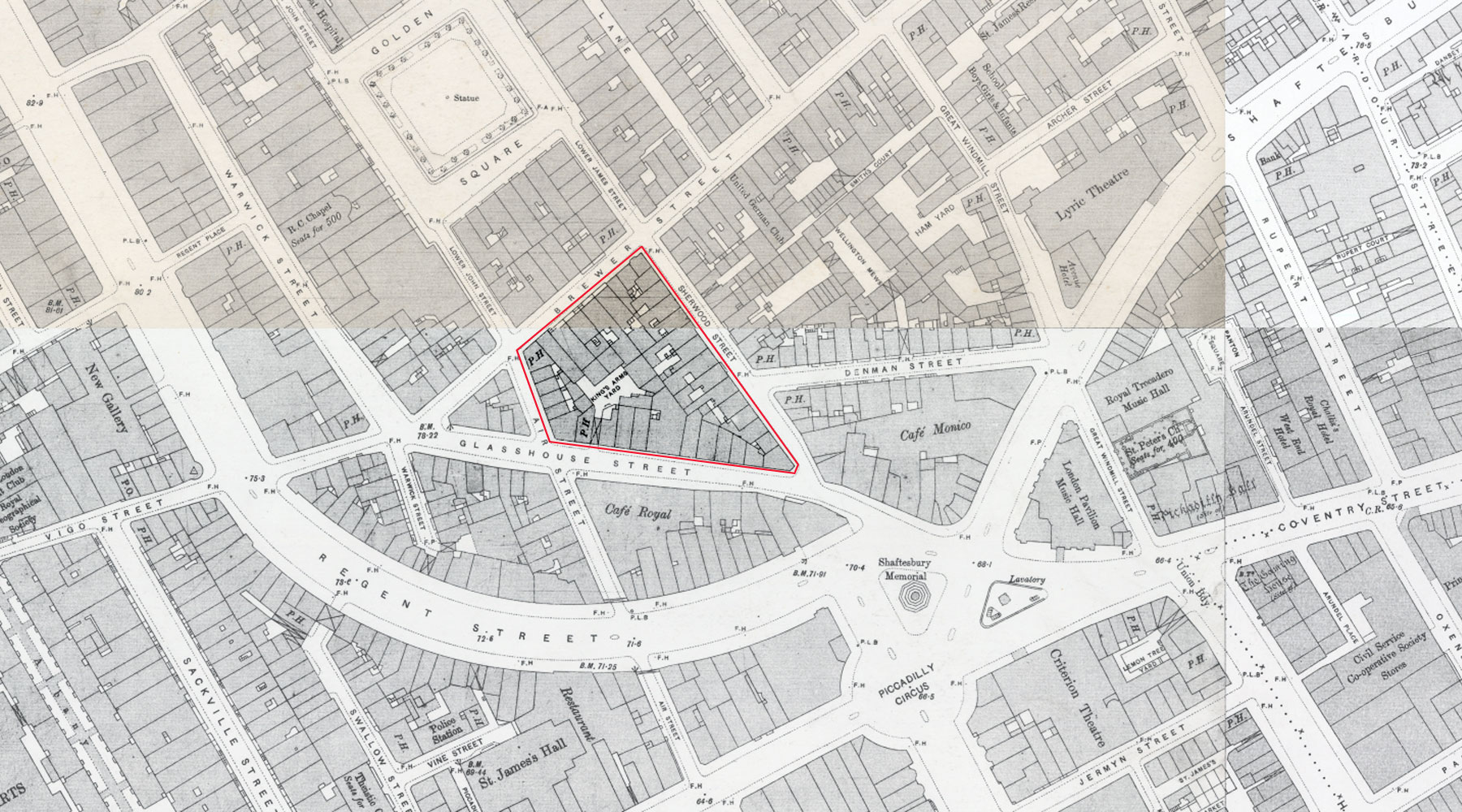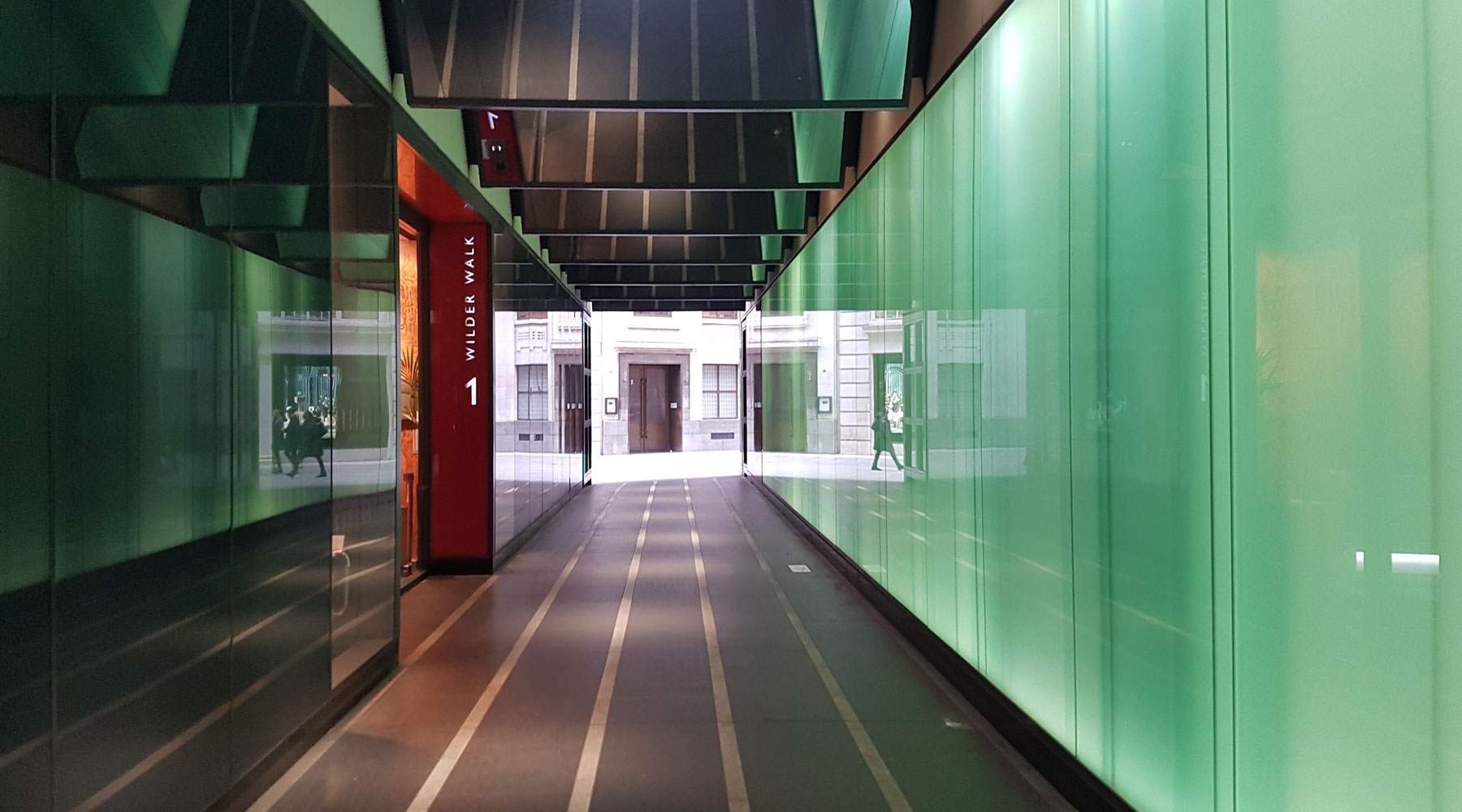This is a new alley next to Piccadilly Circus caused by a recent redevelopment of the Regent Palace Hotel, and it’s not a restoration of an old alley, it’s entirely new.
The area first appears on William Morgan’s map of 1682 as a new development on the very edge of London. This was all once fields. Before the Regent Palace Hotel was built in 1912-15, the whole block was a cluster of shops and officers with a small long since lost yard in the middle.
Built by J Lyons, when it opened in 1915, with 1,028 bedrooms, it was the largest hotel in Europe. Although it was said to have had the opulence and scale of a transatlantic liner, in post-WW2 years it declined to the point that it ended up being a cheap hotel for backpackers.
Which was quite a climbdown for a building that’s owned by the Crown Estate.
Your correspondent once spent a very drunken night in the hotel while working on a trade show, sitting with colleagues next to an internal pub that had a tendency to let customers stock up on beers at last orders then spend the next few hours sitting in the lobby.
The hotel closed in 2006, and a couple of years later permission was given to gut the entire interior and rebuild it behind retained facades on two sides as an office block. That is now known as Quadrant 3, and while most of the interior is a clean modern design, they’re retained the art deco elements on the ground floor.
One of the more striking features of the new development is the use of rich faience tiles in greens and blues that are a subtle nod to the former hotel’s Edwardian grandeur. In a twist, the southern nose of the hotel frontage that remains today was the part that was damaged during WW2. Later repaired, it survived the demolition of the back three-quarters of the back of the hotel.
It was this redevelopment that caused the alley to appear, in a place where it couldn’t have in the past as it would have run right through the hotel lobby. The alley is not just a passage and entrance to part of the offices though, it’s also an artwork called Timelines.
The art is a light installation encased within layered glass panels along the sides of the alley. We’re told that the movement of the light echoes the passage of the pedestrian through the walkway and creates, in the words of the artist, Daniela Schönbächler ‘an experience indicative of a more natural environment’.
Candidly, most people will notice the other major feature of the alley though – the huge selfie-friendly mirrors on the ceiling, and I saw a number of people stop and pose when walking through.
The name of the new alley? It’s named after Ian Wilder, a former councillor for the area who died in 2009 and is remembered for his work on behalf of people living in Soho.











There’s a Facebook group for former employees of the Regent Palace Hotel with some interesting photos I think. And wasn’t its original restaurant what later became the Atlantic Bar and Grill and is now Brasserie Zedel? Am fascinated by the history of that place, there’s nowhere like it in London. And how marvellous that Mr Wilder has been honoured in that new development.
Yes the three famous public rooms are the core of the place, after Oliver Bernard’s tweaks for the Jazz Age. The grill room with marble pillars and deeply coffered ceiling was further enhanced with brass and new lighting, a smoking and reading room was re-clad in stained birch panelling trimmed with metal strips and had its column capitals composed in stacked glass discs to become a bar, and a circular billiard room was remodelled as the Chez Cup (a play on ‘shake up’) cocktail lounge, a frenzy of coloured glass, banded walls and radially-set wood block flooring. All were underground; the ground floor coffee room was transformed into a dazzling restaurant with black columns, pistachio coloured walls and plenty of glass and gold. These rooms survived for decades, trading mostly as the Atlantic Bar and Grill, and were restored to a degree in 1994. For the Q3 scheme though all four spaces been restored or recreated, but the ground floor restaurant was dismantled, rotated and slotted into a corner of the basement, joining the others but with a separate entrance from street level.
Hi IanVisits. The expansion of the hotel site led to the destruction of Hickfords Rooms, a significant venue in the history of c18 London concert life, where – for example – the young Mozart performed. Hickfords was the platform of choice for many of the great solo musicians of the age for their London ‘behefit’ nights, as well as a well-known meeting place for other social/cultural events. Amazing to me that Hickfords was pretty much intact until 1930s. Apols if you knew this already. [More @ https://www.british-history.ac.uk/survey-london/vols31-2/pt2/pp116-137#h3-0010 ]